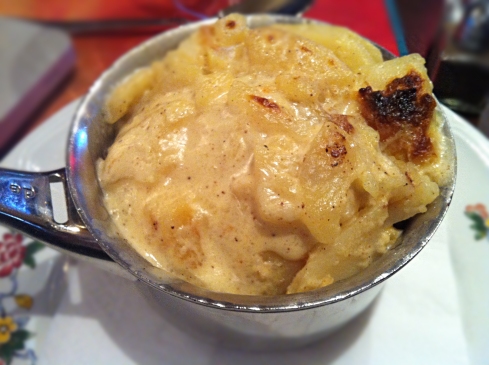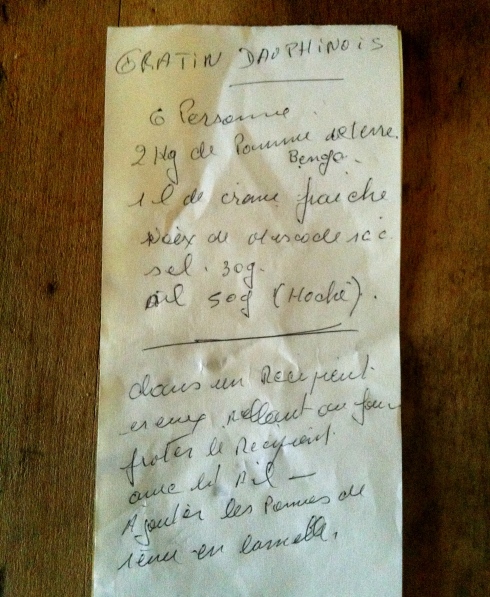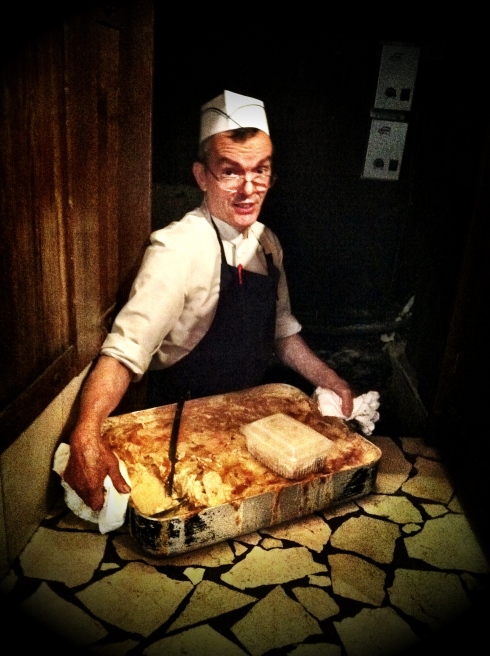It was cold and miserable outside…. the Parisian winter is setting in. My friend and I stepped into the l’Auberge Rouge– a non-descript neighbourhood brassiere, to simply take a drink and catch up. I ordered the best red wine on the menu in an attempt to lift my spirits and defrost a little. The wine was not good at all. I drank it anyway. But then, halfway through our conversation, something happened. Both of us stopped talking, mid-sentence.
Something was cooking. And it smelt incredible.
We both looked around, frantically trying to identify the source of this heavenly smell, and then…. there it was. In front of our eyes, the source literally emerged before us.
A quintessential French chef, like a scene out of a 1920’s film, emerged slowly from a hidden underground kitchen. He was holding an enormous dish of creamy, cheesy, dreamy-looking BAKED POTATOES.
My usual curious self, driven only by my eyes and stomach, was now on a mesmerised mission. I jumped to my feet and walked over, making a beeline to the chef approaching:
“Monsieur, please, what is that exactly? It smells absolutely divine!”
With a big warm smile, ‘Mr Very French Chef’ in front of me responded:
“Ah madame, ça- ça c’est mon fameux Gratin Dauphinois!”
“Ahhhhh! Bien sûr! Le classique Gratin Dauphinois!” I responded, not at all surprised that something consisting of potatoes and melted cheese was responsible for this intoxicating allure.
However, it was not enough for me, I simply had to know more.
“But what did you put in there? It smells sooooo good!”
The chef chuckled, grinning with pride at the attention, but responding with full modesty:
“Well, it’s quite simple actually… potatoes, garlic, cream and nutmeg.”
“That’s it? What about the cheese, what kind of cheese goes in your gratin?” I queried.
“Cheese? Oh no no, there is no cheese, madame. The traditional recipe for Gratin Dauphinois is only done only with cream, not cheese.”
And from this point on, my ‘Aussie inquisition’ began, and whilst quizzing my new chef friend about his gratin, before I knew it, a mini pot of the gratin had been served up and whisked over to our table.

The culprit: Mr Christian Dauve’s amazing Gratin Dauphinois served up before us, moments before being devoured
We had just finished lunch an hour ago. Of course, we ate it anyway. And yes- it tasted just as good as it smelt- really, really, really damn, GOOD.
So good, in fact that I went back the next day and asked my new chefy friend for the recipe. In the end I got much more than the recipe- I walked away with a full history lesson on the Gratin Dauphinois and a new knowledge and appreciation of the origin of food, including some fascinating facts on the main ingredient- the humble potato.
So for a quick ‘French food history lesson’, this is how the story of the Gratin Dauphinois goes:
Scroll down if this has made you so hungry that you just want to get to the recipe!
Why does the traditional version of Gratin Dauphinois not have cheese?
Back in the 17th Century in the Haute Savoie region of France, cheese was practically a form of currency- it was an aliment of its own. Cooking with cheese it was unthinkable, and would have been extremely wasteful, not to mention expensive.
Farmers would milk their dairy cows in two rounds. The first round was called “le Bloche”– this was literally the cream of the cream. The first round is rich and very creamy. This would be then put aside and sold to local artisanal cheese makers who would produce quality butter and rich mountain cheeses such as the famous Comté .
The second batch of cows milk was called the “Re-bloche” (‘re-milking’) and results in milk which has a lower cream content and is less ‘rich’. The ‘rebloche’ would be kept by the farmers themselves and used for milk, cream, and for making a secondary cheese- the wonderful “Reblochon.”
The cheese was of course sold, and the cream would be used for cooking and enriching regional specialities such as the ‘Gratin Dauphinois’.
How did potatoes first arrive in France? We can thank the Americans.
It’s hard to imagine French cuisine without potatoes- they are such an inherent part of French food today that I never imagined this staple was an introduced product and has only been part of the French diet since Louis XVI in the 17th Century. My new chef friend Monsier Dauve was like a talking food history book as he explained the origins.
Apparently Jacques Quartier brought potatoes to France after an expedition exploring the Americas. In France, Count Parmentier (yes there is a potato dish named after him) a pharmacist, chemist and employee of Louis XVI, planted them in a garden with the intention of growing and harvesting the potato on a mass scale in order to feed the French peasant population. Unfortunately the potato was not an instant hit with the French who, at the time regarded it with great suspicion and fear. Since in its raw green state the potato is somewhat poisonous and not even dogs would eat them, the potato was a hard sell for Parmentier until he adopted a bit of reverse psychology.
Parmentier planted 50 acres of potatoes on a plot of land on the outskirts of Paris. During the day, he instructed a royal guard to watch over it. When the locals noticed that that the crop was of such value that royal guards were protecting it, their curiosity grew and hoards of people came to see what all the fuss was about. The trick worked. The potato gained a heightened intrinsic value overnight, and very quickly attracted widespread acceptance – today being one of the major foods in Europe and the rest of the world.
So that’s probably enough history on cheese and potatoes now- let’s get down to the best bit: Monsier Dauve’s amazing recipe. Don’t bother trying to read his handwritten version in the photo- I’ve translated if for you below. Enjoy!

The original, handwritten recipe given to me by chef Christian Dauve (Here's a pic, just to prove I'm not making it up)
Recipe: Traditional Gratin Dauphinois
Ingredients:
(Serves 6)
• 2 kilograms Bintje potatoes
(Bintje potatoes have a high moisture content and are low in starch, making them a ‘waxy’ variety. They are oval in shape, with pale yellow flesh).
• 3 cloves of garlic
• 1 litre fresh cream
• 1 heaped tbsp salt
• Half teaspoon freshly ground nutmeg
And that’s it!
Here’s how you make it:
Preheat the oven to 200 Degrees Celsius
Using a large baking/casserole dish- either metallic or ceramic, finely grate the garlic cloves into the dish evenly so the inner surface is sprinkled with garlic. This is important- the garlic needs to be on the base of the dish, and not IN with the potatoes. This way it flavours the potatoes aromatically during the cooking time without having actual pieces of garlic throughout the potato gratin.
Wash and peel the potatoes. Slice them into rounds approximately 3-4 mm thick. And evenly layer and distribute them into the dish.
Sprinkle the sea salt and nutmeg over the top
Lastly, pour the cream evenly over the top of the potatoes. By adding the cream last, it distributes the salt and nutmeg throughout.
Bake the potatoes in the oven for one hour, uncovered. The actual magic happens in the last 20 minutes of cooking when all the ingredients are at boiling temperature and the potatoes soften with the cream then develop a golden crust on the top.
Remove from the oven, leave to cool slightly, then spend the next hour answering the front door as the neighbours pass by to find out what that divine smell is wafting from your kitchen…
















